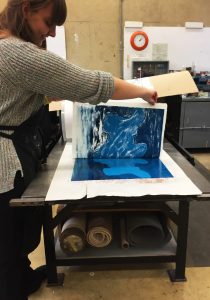 Printmaking is the artistic process of transferring images from a matrix onto another surface, most often paper or fabric. Rembrandt, Goya and Gauguin were all printmaking masters.
Printmaking is the artistic process of transferring images from a matrix onto another surface, most often paper or fabric. Rembrandt, Goya and Gauguin were all printmaking masters.
For the first time, Wright State University will offer a printmaking course to non-art majors. Some basic drawing skills for the Spring Semester course will be useful but not essential.
The move comes as the Department of Art and Art History offers other art courses to non-art majors, including Beginning Drawing, Photography, Art History and Ceramics, which have quickly grown in popularity in just a few years.
“A lot of students come to college and had an interest in art in high school,” said Glen Cebulash, chair of the Department of Art and Art History. “It’s not an area they want to major in, but they don’t want to lose touch with that outlet that was meaningful to them.”
Cebulash said many non-art majors also feel that taking art courses gives them an edge when they dive into the job market following graduation.
“An engineering student is not necessarily going to stand out from the hundreds of other engineering students by virtue of the fact that they are engineers,” he said. “The ones who have done something outside of the typical wheelhouse like visual arts, suddenly they become a standout in some ways.”
Kim Vito, professor of art, has taught printmaking for 32 years.
“The process of creating a print becomes a collaboration between the medium and the artist,” she said. “Students can realize an idea through image-making. They will gain an appreciation for fine-hand printed images, be able to identify works in print and learn about artistic self-analysis through critiques.”
The print studio in the Department of Art and Art History is equipped with several printing presses, providing students with the environment to explore a wide range of print media including relief, mono-printing, intaglio and lithography.
Students should have an interest in the production of images and patterns and enjoy working with tools and equipment. Most printmakers are good problem solvers.
“Creative arts enhance disciplines that might not traditionally be thought of as creative and help students think outside of the box,” said Cebulash.
Stefan Chinov, professor of art, has taught sculpture and ceramics for 20 years.
“We first offered a non-majors class in ceramics two years ago and it has been a success,” he said.
Ceramics is one of the oldest art forms, as ancient as the oldest artifacts ever found, from sculptures to pottery.
“It is one of the most direct and accessible ways to engage in and enjoy a creative process, to make things, and to get involved in the full range of what plastic arts can offer, from making shapes in clay to glazing surfaces in vibrant colors to the excitement of regaining the fired objects from the kiln,” said Chinov.
There are no prerequisite requirements for the course. Chinov said all a student needs is the aspiration to make artistic objects or the curiosity to try the process.
“I think that the idea of a ‘non-major’ art class is that there is an artist in everyone rather than that everyone is an artist,” he said. “To be successful in a class like Ceramics for Non-Majors, students need to simply engage in the process and free their imaginations.”
The course covers historical and contemporary ceramics from different cultures around the world and teaches methods and techniques as well as stylistic possibilities.
“Skill is acquired to the extent that it’s needed, and this is individual,” said Chinov. “Really, it’s about students’ own creativity as much as it is about the methods that we cover.”
He said ceramics are everywhere, from sculpture to dinnerware to bathroom fixtures.
“Whether it becomes more than a hobby or remains a one-time experience, few things are so rewarding as getting your own unique piece out of the kiln, glazed and solidified into an everlasting material,” he said.
Chinov said people learn things in ceramics at a different pace and there is something enjoyable and gratifying at every state regardless of how inexperienced or advanced they may be.
“You learn the process as you go and your first pieces are as important as your next ones,” he said. “The process is flexible and, unlike learning a foreign language, you can start using it immediately and soon there is a sense of a breakthrough. A vision forms and you anticipate the next step. This is something that happens a lot in visual arts classes, and it’s a terrific experience.”

 Milling around
Milling around  Wright State recognizes Nursing Professor Kim Ringo for advancing international student success
Wright State recognizes Nursing Professor Kim Ringo for advancing international student success  Wright State honors graduating students for distinguished doctoral dissertations
Wright State honors graduating students for distinguished doctoral dissertations  Top 10 Newsroom videos of 2025
Top 10 Newsroom videos of 2025  Museum-quality replica of historic Hawthorn Hill donated to Wright State
Museum-quality replica of historic Hawthorn Hill donated to Wright State 